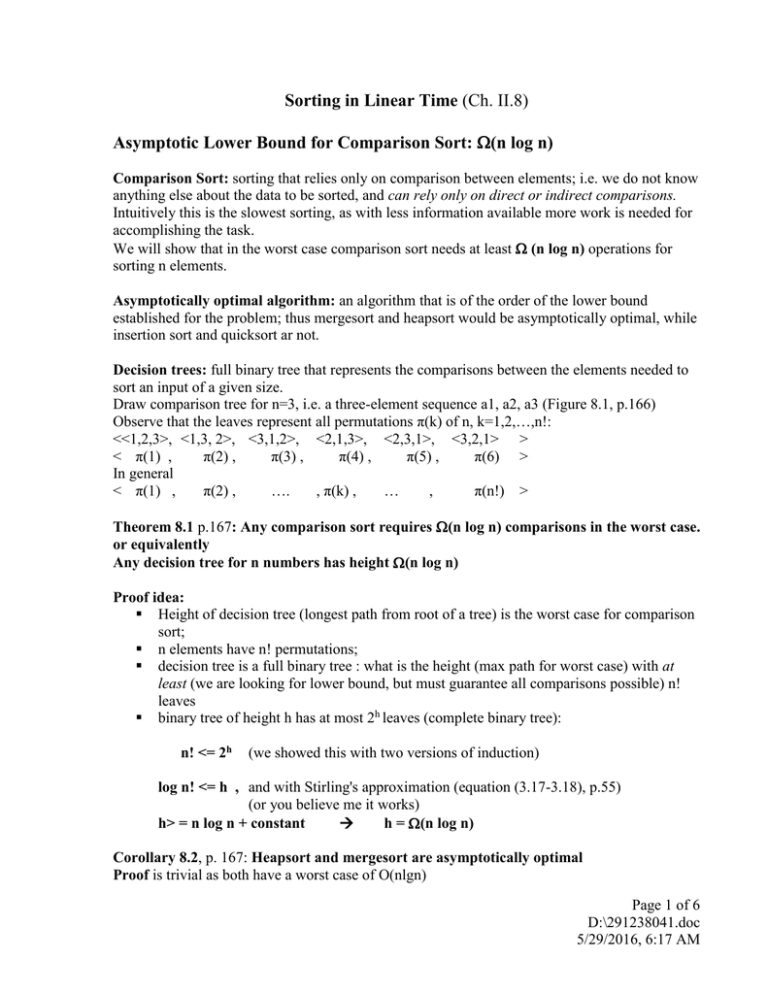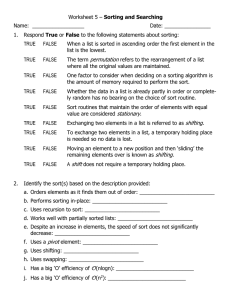Sorting in Linear Time Asymptotic Lower Bound for Comparison Sort:
advertisement

Sorting in Linear Time (Ch. II.8) Asymptotic Lower Bound for Comparison Sort: (n log n) Comparison Sort: sorting that relies only on comparison between elements; i.e. we do not know anything else about the data to be sorted, and can rely only on direct or indirect comparisons. Intuitively this is the slowest sorting, as with less information available more work is needed for accomplishing the task. We will show that in the worst case comparison sort needs at least (n log n) operations for sorting n elements. Asymptotically optimal algorithm: an algorithm that is of the order of the lower bound established for the problem; thus mergesort and heapsort would be asymptotically optimal, while insertion sort and quicksort ar not. Decision trees: full binary tree that represents the comparisons between the elements needed to sort an input of a given size. Draw comparison tree for n=3, i.e. a three-element sequence a1, a2, a3 (Figure 8.1, p.166) Observe that the leaves represent all permutations π(k) of n, k=1,2,…,n!: <<1,2,3>, <1,3, 2>, <3,1,2>, <2,1,3>, <2,3,1>, <3,2,1> > < π(1) , π(2) , π(3) , π(4) , π(5) , π(6) > In general < π(1) , π(2) , …. , π(k) , … , π(n!) > Theorem 8.1 p.167: Any comparison sort requires (n log n) comparisons in the worst case. or equivalently Any decision tree for n numbers has height (n log n) Proof idea: Height of decision tree (longest path from root of a tree) is the worst case for comparison sort; n elements have n! permutations; decision tree is a full binary tree : what is the height (max path for worst case) with at least (we are looking for lower bound, but must guarantee all comparisons possible) n! leaves binary tree of height h has at most 2h leaves (complete binary tree): n! <= 2h (we showed this with two versions of induction) log n! <= h , and with Stirling's approximation (equation (3.17-3.18), p.55) (or you believe me it works) h> = n log n + constant h = (n log n) Corollary 8.2, p. 167: Heapsort and mergesort are asymptotically optimal Proof is trivial as both have a worst case of O(nlgn) Page 1 of 6 D:\291238041.doc 5/29/2016, 6:17 AM Counting Sort Additional information available: range of values of elements is known. Assume: all A[j] are in the range [0, k] , with j=1..n Main Idea: for every element find out how many elements come before (are less/equal) it. This is accomplished by (a) first counting how many times a given value occurs, and saving the number of occurrences o this value in a corresponding counter. This is possible because we know the range of values and can assign a counter for each of them (obviously this could not be done if no information about the values to be sorted were available). (b) After we know the number of occurrences of all input values, all we need for determining the place of a specific element is to sum up the counters for all the smaller values – this way we will know how many elements are in front of a any input element. (c) Then we traverse array A a second time, and, base on the information in (b) put every input element in its final place. Now let's work out the details: we define C[1..k] – a counter array, with C[i], i = 0..k , stores first (a) the number of occurrences of each value i in the range of possible values [0..k]; and then (b) the number of input elements (in the current, specific input array A for which the algorithm is run) that come before value i. A[1..n] – input array, with A[j], j = 1..n (as usual) B[1..n] – output array that stores the sorted sequence, with B[j], j = 1..n (Note that we did not need this type of array for insertion sort, heapsort, or quicksort. What property do these latter sort algorithm have, and counting sort does not, which makes it possible for them to use A as output array, and thus avoid the use of an additional output array?). Page 2 of 6 D:\291238041.doc 5/29/2016, 6:17 AM Example on board: 3, 5, 4, 1, 3, 4, 1, 4 in the range of [0, 5] A j C 1 2 3 4 5 6 7 8 0 1 2 3 4 5 3 5 4 1 3 4 1 4 0 0 0 0 1 0 0 1 2 3 4 5 6 7 8 8 7 6 5 4 3 2 1 1 1 1 2 2 2 C after counting occurrences of A[j]: C after summing up all counter values: B[ C[ A[j] ] ] = A[j] 4 1 4 3 1 4 0 0 2 2 0 2 2 4 3 3 7 6 1 5 3 0 4 5 1 1 3 3 3 4 4 4 1 8 5 7 2 final C values irrelevant ---------------------------------------------------------------------COUNTING-SORT(A, B, k) //p.168 for i = 0 to k C[i] = 0 //counter initialization to 0 (k) for j = 1 to n //count occurrences of value A[j]: step (a) C[A[j]] ++ //increment value A[j] counter (n) for i = 0 to k C[i] += C[i-1] //sum up all counter for values <= i (k) for j = n downto 1 //traverse A putting element in final place according to C B[ C[ A[j] ] ] = A[j] //final position of A[j] in B is at index C[A[j]] C[A[j]] -- //decrement the counter after element has been placed (n) ---------------------------------------------------------------------Performance of Counting Sort: (n + k) Page 3 of 6 D:\291238041.doc 5/29/2016, 6:17 AM Stable sort: same value elements appear in the output in the same order as in the input, i.e. ties are broken with the rule "whichever appears firs in input appears first in output". This property is important e.g. if there are satellite data that need to preserve the input order. Example on board: A 1 2 3 3 5 4 4 1 5 3 6 4 7 1 8 4 retrace the example with the satellite data to obtain the sorted sequence 1 1 2 1 3 3 4 3 5 4 6 4 7 4 8 5 Another example in shown in Figure 8.2, p.169 Page 4 of 6 D:\291238041.doc 5/29/2016, 6:17 AM Radix Sort Additional information available: all elements of A have (at most) d digits, with 1 the least significant and d the most significant digit; and the digits take k values RADIX-SORT( A, d) for i=1 to d stable sort of array A on digit i d A[1] A[2] . . . A[n] . . . … … … … … i . . . … … … … 3 2 1 … Trace example in Figure 8.3, p.171 and in exercise 8.3-1 p. 173 Performance of Radix Sort: worst case T(n) = d* T (Stable Sort of n elements with range 1…k) T(n) = d * T (n + k) = T(d * (n + k) ) Page 5 of 6 D:\291238041.doc 5/29/2016, 6:17 AM Bucket Sort Additional information available: range of values of elements known Assume: values of all elements are in [0, 1) Note that this is no restriction to the generality of the algorithm as any interval [a,b) can be mapped to [0,1] Main idea: - divide [0,1) in a number of equal size intervals, called buckets; - distribute values across buckets chaining values that end up in the same bucket in lists; - sort the list associated with each bucket – on average it will be much shorter than the initial list: this is the reason for faster performance - concatenate the sorted lists. Trace example in Figure 8.4, p.175 and in exercise 8.4-1 p. 177 ---------------------------------------------------------------------BUCKET-SORT(A) for i=1 to n insert A[i] into list at B[ floor( n* A[i] ) ] (n) for i=0 to n-1 sort list B[ i ] with insertion sort (n2) Concatenate the lists B[0], B[1], …, B[n-1] together ---------------------------------------------------------------------Total worst case time (n) (n2) Average asymptotic time: given a uniform distribution of input values bucket sort runs (n) at average. Proof idea: Intuitively, as the values disperse evenly across the buckets, the average list length linked to a bucket is the same for all buckets, and the average sorting time for a sorting the list B[i] is constant, thus making the second for-loop (n) instead of (n2). For a rigorous proof see p.175 Page 6 of 6 D:\291238041.doc 5/29/2016, 6:17 AM



